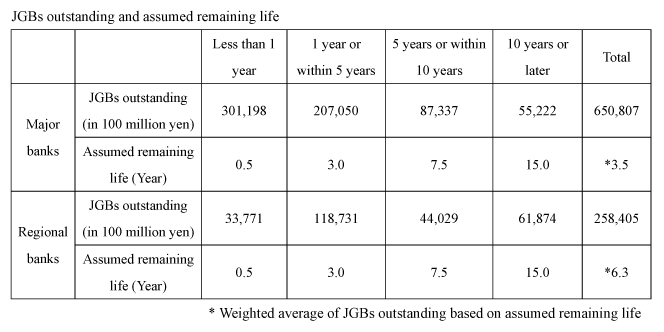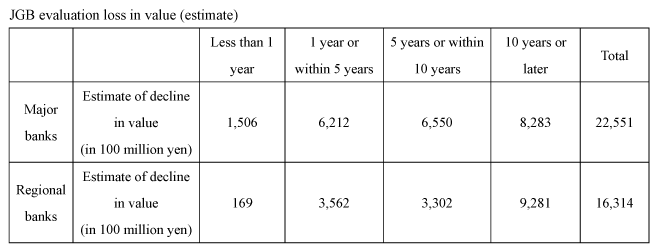Appended Note 1-6 Impact of a Rise in Long-Term Interest Rate on JGBs Held by Banks
- Japanese
- English
(1) Premise of calculation: Consolidated FY2004 financial statements of major banks (3 major financial groups (*) and regional banks (64 banks).
(*) Mitsubishi UJF Financial Group, Sumitomo Mitsui Financial Group, and Mizuho Financial Group.
Of the "Other Securities," those having maturities, and JGBs classified as "Securities Held to Maturity" were used for the calculation.
(2) Calculation method
As to the remaining life of JGBs, we assumed that those maturing in less than one year is 0.5 year, those maturing in one year or within 5 years is 3 years, those maturing in 5 years or within 10 years is 7.5 years, and those maturing in 10 years or later is 15 years.
We also assumed that the yield curves shift 1% upward in parallel throughout the remaining life.
The rate of the decline in value of JGBs is:

(P: price of JGBs, y: remaining life, i: yield of interest)


| Note: | Since the calculation is designed to get a general idea of the impact of a rise in interest rates on JGB prices, it is based on several assumptions. For instance, it assumes that the composition of the outstanding JGBs is constant. Therefore, calculation results are different from the actual impacts on balance sheets. For instance, the JGBs maturing in "10 years or later" include 15-year variable rate JGBs. Since, theoretically speaking, the price of the 15-year variable rate JGBs does not change, if all yield curves are assumed to shift in parallel throughout their remaining life, the decline in value of the JGBs maturing in "10 years or later" will be smaller than the calculation result. |
